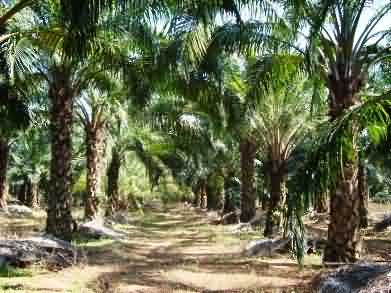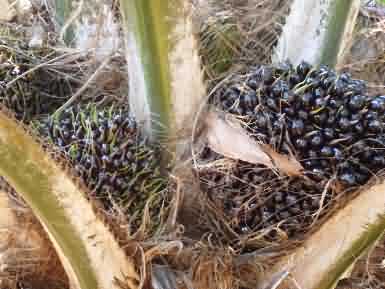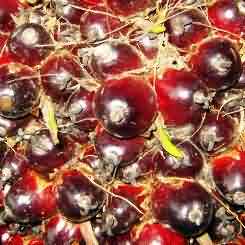Oil palm (Elaeis guineensis Jacq.) is the highest edible oil yielding perennial crop producing two types of oil i.e. crude palm oil and palm kernel oil which are used for domestic and industrial purposes. It produces about 4 to 6 tonnes of crude palm oil and 0.4 to 0.6 tonnes of palm kernel oil per hectare per year during its productive life span from 4th to 30th years.
Oil Palm is a heavy feeder and it requires a balanced and adequate supply of macro and micro-nutrients for growth and yield.
Fertilizer requirement of Palm
Recommended nutrient for oil palm grown under rainfed condition is given in Table 1. It is advised to apply 400-200-400-125 g of N-P2O5-K20-MgSO4 per palm per year during the first year of plantation, 800-400-800-250 g of N-P2O5-K20-MgSO4 per palm per year during second year of plantation and 1200-600-1200-550 g of N-P2O5-K2O-MgSO4 per palm per year during third year onwards.
Fertilizer requirements as per the availability of different fertilizers available in the market are given in Table 2. Research on oil palm nutrition conducted at different agro-climatic locations namely Gangavathi (Karnataka), Mulde (Maharashtra), Vijayarai (Andhra Pradesh) and Aduthurai (Tamil Nadu) revealed that the dose of fertilizer varied from place to place.
The dose of 1200-600-1200 g of N-P2O5-K2O per palm per year was found to produce FFB yield of 12-15 t FFB ha-1 at Tungabhadra command area of Karnataka whereas, application of 800-400-1800-500 g N-P2O5-K2O- MgSO4 per palm per year resulted in the production of 18 to 19 t FFB ha-1 under sandy loam soils of Andhra Pradesh.
However, efforts must be made to modify these doses based on soil and leaf analysis. Borax at the rate of 100 g/palm/year is recommended in boron deficient soils or when the boron deficiency symptoms are noticed. If organic nutrient sources like FYM, green manure and neem cake are available, then 50-100 kg of FYM or 100 kg of green manure per palm per year can be applied.
Neem cake at the rate of 5 kg/palm/year can also be applied. Whenever organic fertilizers are applied, nitrogen applications through chemical fertilizers need to be reduced proportionately.
Table 1. Recommended dose of nutrients for oil palm
|
Age of the Palm (Years) |
Nutrients (g/palm/year) |
|||
|
N |
P2O5 |
K2O |
MgSO4 |
|
|
I |
400 |
200 |
400 |
125 |
|
II |
800 |
400 |
800 |
250 |
|
>III |
1200 |
600 |
1200 |
500 |
Table 2. Fertilizer requirement for oil palm
|
Fertilizers |
Fertilizer requirement (g/palm/year) |
||
|
Age of the palm (years) |
|||
|
I |
II |
>III |
|
|
Urea Single super phosphate (SSP) Muriate of potash (MoP) Magnesium sulphate |
870 1250 670 125 |
1740 2500 1340 250 |
2610 3750 2000 500 |
|
Urea Diammonium phosphate (DAP) Muriate of potash (MoP) Magnesium sulphate |
700 435 670 125 |
1400 870 1340 250 |
2100 1305 2000 500 |
|
Urea Rock phosphate Muriate of potash (MoP) Magnesium sulphate |
870 1000 670 125 |
1740 2000 1340 250 |
2610 3000 2000 500 |
|
Ammonium sulphate Single super phosphate (SSP) Muriate of potash (MoP) Magnesium sulphate |
1942 1250 670 125 |
3884 2500 1340 250 |
5825 3750 2000 500 |
|
Ammonium sulphate Rock phosphate Muriate of potash (MoP) Magnesium sulphate |
1942 1000 670 125 |
3884 2000 1340 250 |
5825 3000 2000 500 |
|
Ammonium sulphate Diammonium phosphate(DAP) Muriate of potash (MoP) Magnesium sulphate |
1562 435 670 125 |
3124 870 1340 250 |
4685 1305 2000 500 |
Note: Urea (46% N), Ammonium sulphate (20.6% N), Diammonium phosphate (18% N, 46% P2O5), Single super phosphate (16% P2O5), Rock phosphate (20% P2O5), Muriate of potash (60% K2O)

Healthy oil palm plantation


Palm crown with fresh fruit bunches Fruits in a bunch
Choice of fertilizers in Palm garden
Nitrogen: In Oil Palm plantations, fertilizers like urea, ammonium sulphate and diammonium phosphate may be used as a source of nitrogen as per their availability in the market. However, urea is found to be cheaper. There is a strong interaction between N and P fertilizers as applied N fertilizer will not be efficiently utilized unless adequate P fertilizer is applied.
Phosphorus: Fertilizers like single super phosphate, rock phosphate and diammonium phosphate can be applied as a source of phosphorus nutrition. Rock phosphate is generally profitable in oil palm as compared to super phosphate. However, under high pH conditions, application of rock phosphate is not recommended.
Potassium: Potassium may be applied as chloride or sulphate according to availability and price. Potassium chloride (Muriate of potash) is found to be cheaper and available in local market.
Magnesium: Magnesium sulphate can be applied as a source of Mg to oil palm.
Frequency of fertilizer application in palm
It is advised to apply fertilizer in four equal splits at three months interval under irrigated conditions. Irrigation should be given immediately after fertilizer application.
Under rainfed conditions, fertilizer application should be made shortly before the onset of the rainy season and not before or during the dry season or in the middle of the rains, and are generally given in two splits.
Methods of fertilizer application in Oil Palm
All the fertilizers should be evenly broadcasted over the clean weeded circles about 1 m away from the palm base and incorporated into the soil with the help of forks.
The area of application should be extended as the weeded palm circles become progressively enlarged as the palm gets older.
Under normal circumstances, N and K fertilizers should be applied in close sequence followed by Mg, P and B fertilizers. Fertilizers can be mixed in water when drip irrigation method is followed.

Fertilizer application in oil palm
The fertilizer requirements of oil palm depend on many interrelated factors that vary from one environment to another.
Even in superficially similar agro-ecological environments, the yield responses of oil palm to fertilizers can vary substantially. Thus, the easiest way to determine fertilizer requirements of oil palm is from fertilizer response trials but it is difficult, time consuming and costly to conduct them in different environments, where oil palm is grown.
For most of the crops including oil palm, relationship between leaf analysis value and plant productivity is generally evident and an assessment of fertilizer needs can be based on such analysis. However, for a cost effective approach, leaf analysis has to be integrated with soil analysis.
This is because, there may be instances where plant uptake of nutrients present in adequate amounts in the soil may be inhibited by the lack of another limiting element, i.e. uptake of K can be reduced by lack of N. In a case of this kind, leaf analysis will reflect the need for N and K fertilizer.
Reference to soil analysis will indicate that the K reserves in the soil are adequate and thus K fertilizers need not be used. This allows savings in the cost of inputs.
Authors:
S. K. Behera1, B. Narsimha Rao2, K. Suresh2,M. V. Prasad2, K. Manorama2 and K. Ramachandrudu1
1Senior Scientist, 2Principal Scientist, Directorate of Oil Palm Research,
Pedavegi -534 450, West Godavari District, Andhra Pradesh
1Email:
